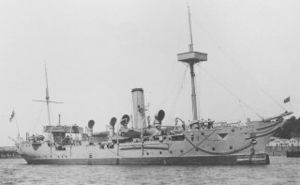Condor class sloop
 
Shearwater under sail (top)
Rinaldo c. 1908 with sailing rig removed (bottom) |
|
| Class overview | |
|---|---|
| Name: | Condor-class sloops |
| Builders: | |
| Operators: |
|
| Built: | 1898-1900 |
| In commission: | 1898–1932 |
| Completed: | 6 |
| Lost: | 1 |
| General characteristics | |
| Type: | Screw steel sloop |
| Displacement: | 980 tons |
| Length: | |
| Beam: | 32 ft 6 in (9.91 m) |
| Draught: | 11 ft 6 in (3.51 m) |
| Installed power: | 1,400 hp (1,044 kW) |
| Propulsion: |
|
| Sail plan: | Barque-rigged, changed to barquentine-rigged, later removed |
| Speed: | 13 kn (24 km/h) under power |
| Endurance: | 3,000 nmi (5,600 km) at 10 kn (19 km/h) |
| Complement: | 120-130 |
| Armament: | |
| Armour: | Protective deck of 1 in (2.5 cm) to 1 1⁄2 in (3.8 cm) steel over machinery and boilers. |
The Condor class was a six-ship class of 10-gun screw steel sloops built for the Royal Navy between 1898 and 1900. Condor foundered in a gale, prompting the Royal Navy to abandon sailing rigs for its ships. The last of the class, Mutine, survived until 1932 as a Royal Naval Volunteer Reserve drill ship.
The Condor class was constructed of steel to a design by William White, the Royal Navy Director of Naval Construction. They were powered by a three-cylinder vertical triple expansion steam engine developing 1,400 horsepower (1,000 kW) and driving twin screws.
The class was originally designed and built with barque-rigged sails, although some pictures show ships of the class with a barquentine rig. Condor was lost in a gale during her first commission, and the contemporary gunnery pioneer Admiral Percy Scott ascribes her sinking to the encumbrance of sails, and furthermore believed that her loss finally convinced that Admiralty to abandon sails entirely. All other ships of the class had their sails removed during the first few years of the twentieth century.
The class was armed with six 4-inch/25-pounder (1 ton) quick-firing breech loaders and four 3-pounder quick-firing breech loaders.
The design of the Condor class differed from the screw sloops of the 1860s only in an evolutionary sense (although constructed of steel and armed with quick-loading guns, they retained the sails and layout of the earlier vessels); by the turn of the twentieth century they were thoroughly obsolete. The overseas stations of the Royal Navy were responsible for patrolling the maritime British Empire, and these ships were intended for that role. The rapidity with which they were converted to depot ships, training ships or survey ships gives testament to their outmoded design. According to Hansard, it was stated by the Secretary to the Admiralty about the almost identical Cadmus class in Parliament on 6 March 1905 that
...
Wikipedia
